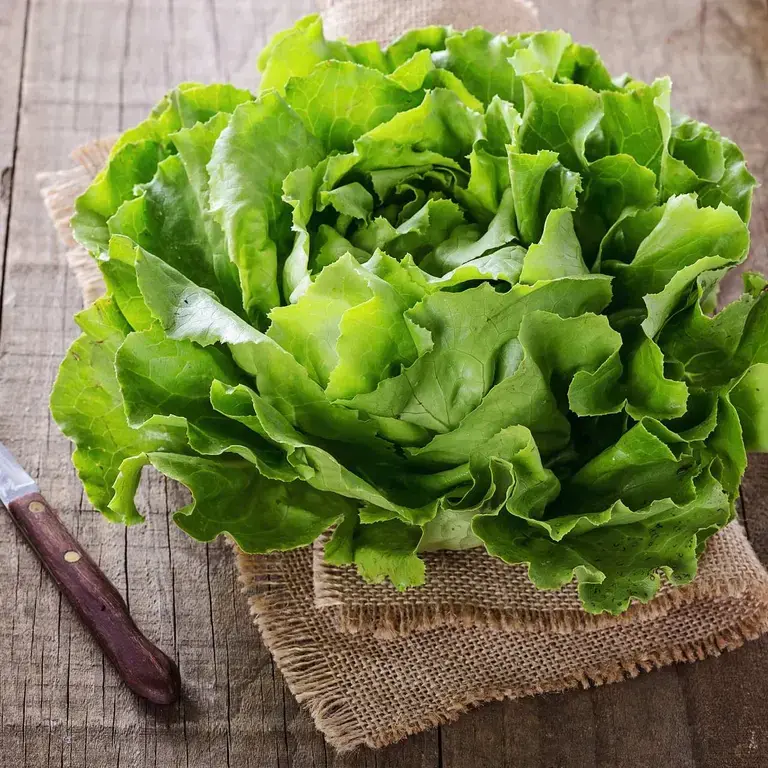If your dish needs a lettuce that’s mild, sweet and tender, butter lettuce is the veggie for you. Use it as a wrap, in salads or sandwiches, or as a bed for other ingredients.

Photo: iStock
What is Butter Lettuce? Benefits, Storage and Recipes

Butter lettuce, also known as Bibb lettuce or butterhead lettuce, is a type of lettuce with large, soft leaves and a tender texture. It is named for its butter-soft texture rather than its flavour, which is mild with a hint of floral sweetness, and pairs well with sharp flavours like strong cheeses, citrus and meat.
A favourite in salads, especially with creamy dressings, or as a bed for other ingredients, butter lettuce can also be used to make lettuce wraps, or to add a mild, subtle crunch to salads. It varies in colour from bright green to a dark purplish red and is sometimes sold with the roots still attached to prevent the fragile leaves from wilting.
You can buy butter lettuce from farmers’ markets or groceries stores, where they can sometimes be seen encased in a protective plastic dome. When buying butter lettuce choose dense, heavy heads, and avoid anything with brown spots or limp, wilted outer leaves.
What does butter lettuce taste like?
Butter lettuce is softer and, unsurprisingly, butterier in texture than other waterier lettuce varieties. It doesn’t exactly have the flavour of butter though, but there’s a definite hint of sweetness and a mellow floral note.
Health benefits

Butter lettuce is low in calories but high in essential nutrients. A 100g serving contains just 13 calories, and is virtually fat free. It contains around 95% water, so it can help you stay hydrated, and may also aid weight loss.
The same serving size contains an impressive 85% of your daily value (DV) for vitamin K, which is important for blood clotting and the healing of wounds. It also provides 18% of your DV for vitamin A, which helps to maintain healthy skin, teeth and bones, as well as 18% of your DV for folate, which helps your body to produce genetic material, and is particularly important if you are pregnant.
Butter lettuce also provides some potassium, manganese and vitamin C, and is actually higher in iron than other types of lettuce. Iron plays an important part in creating red blood cells, but it is important to know that butter lettuce only provides non-heme iron, which is difficult for your body to absorb. Vitamin C can help with absorption, so it may be a good idea to eat your lettuce with foods that are high in this nutrient, like peppers or a lemon juice vinaigrette.
Butter lettuce is also a good source of antioxidants, which help protect your cells from free radical damage that can lead to chronic diseases like cancer. Both vitamins A and C have antioxidant properties, and butter lettuce also contains a group of potent antioxidants called carotenoids, including beta carotene, lutein, and zeaxanthin. These substances help maintain healthy eyesight and protect against macular degeneration, the leading cause of sight loss.
Varieties

There are several varieties of butter lettuce, which can broadly be divided into two types, green-leaf and red-leaf:
The nine green-leaf varieties of butter lettuce are:
Boston bibb
Bibb
Victoria
Divina
Tom Thumb
Kweik
Santoro
Butter Babies
Buttercrunch
The seven red-leaf varieties of butter lettuce are:
Flashy Butter Oak Leaf
Carmona
Skyphos
Blushed Butterhead
Speckles
Yugoslavian Red
Four Seasons
How to prep and store butter lettuce
If your lettuce comes with its roots attached, leave it in its original packaging, as the roots will continue to feed the leaves, keeping them fresher for longer. You can also run the roots under the tap for a second to keep them moist. When you’re ready to eat the lettuce, cut the leaves free by turning the head root-side up, and cutting around the root. You should then wash the leaves well to remove any soil.
If your lettuce doesn’t have any roots, wash and dry the loose leaves before storing, then wrap them in paper towels and seal inside a plastic bag. When refrigerating, avoid the colder areas at the back and bottom of the fridge, as they can cause the leaves to wilt. Stored in this way, butter lettuce should keep for up to a week.
Recipe ideas
Try this mild, tender veggie for yourself with these simple, fresh recipe ideas.

Try this mild, tender veggie for yourself with these simple, fresh recipe ideas for how to use butter lettuce.
Simple butter lettuce salad
This sophisticated side from The Modern Proper takes the simple lettuce leaf to the next level with just a few choice ingredients to enhance its flavour and texture. Crunchy panko breadcrumbs contrast perfectly with the butter-soft texture of the leaves, while salty olives and shavings of aged Manchego cheese add bursts of stronger flavour.
Butter lettuce, avocado and radish salad
This simple salad from Flavour the Moments is another side dish that’s more than the sum of its parts. Soft butter lettuce and creamy avocado create a luxurious mouthfeel, while slices of radish add a peppery punch and contrasting crunchy texture.
Butter lettuce strawberry salad with poppy seed dressing
Soft, light butter lettuce is the perfect base for this flavourful sweet-and-savoury salad from It’s a Veg World After All. Tangy, creamy goat’s cheese blends beautifully with sweet, juicy strawberries, while slices of shallot add a pungent, savoury kick. Serve as an appetiser or a side, or make it into a main dish by adding grilled chicken or chickpeas.
Thai shrimp with lettuce and coriander
This summery seafood starter uses lettuce as a wrap, or cup, to encase aromatic Thai prawns. Butter lettuce is a great choice for this recipe, as the leaves are large, flexible and decorative, and their mild, slightly sweet flavour is more complementary than more bitter varieties.








